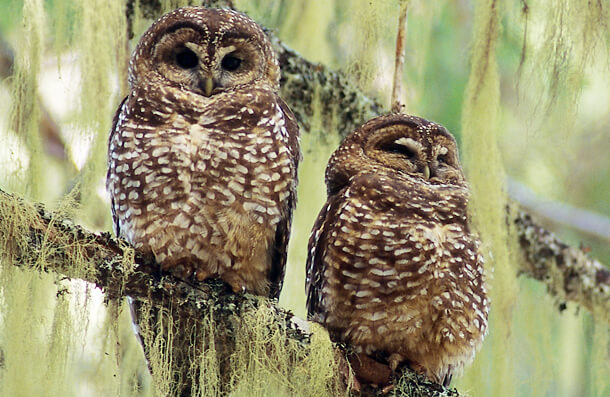BLM Logging Plan Guts President Clinton's Northwest Forest Legacy

The BLM forest management plan announced today will negatively affect Northern Spotted Owls (shown) and Marbled Murrelets, both listed under the Endangered Species Act. Photo by All Canada Photos, Alamy
Contact: Steve Holmer, ABC's Senior Policy Advisor, 202-888-7490
(Washington, D.C. August 5, 2016) The Bureau of Land Management has approved a logging plan for the forests it manages in Oregon, significantly weakening protections for the threatened Marbled Murrelet and Northern Spotted Owl. These protections were put in place in 1994 as part of President Clinton's Northwest Forest Plan.
“The BLM plan is huge step in the wrong direction that ignores science, the dangers of climate change, and the successes of President Clinton's Northwest Forest Plan,” said Steve Holmer, Senior Policy Advisor for American Bird Conservancy. “The BLM is now planning to log mature forests that are needed to recover populations of the threatened Marbled Murrelet and Northern Spotted Owl, and that provide for clean water and carbon storage.”
American Bird Conservancy (ABC) submitted a letter to BLM providing feedback on the plan; ABC also urged Obama administration officials to shelve the proposed plan, instead keeping the Northwest Forest Plan in effect until it can be updated in conjunction with the U.S. Forest Service.
“The Marbled Murrelet, a species listed under the Endangered Species Act, will be placed at great risk by the BLM's plan to increase logging in mature forests,” said Holmer. “The Northwest Forest Plan provided for half-mile buffers around nesting territories. These are needed to ensure sufficient protected habitat around nests in a heavily fragmented landscape. This common-sense safeguard is being abandoned at the same time BLM is proposing to ramp up clearcutting.”
The Marbled Murrelet nests on large branches of mature and old-growth trees. It is listed as a threatened species under the ESA because of habitat loss caused primarily by logging of old-growth forests. An estimated 19,000 birds remain, but the Washington State population is currently in a steep 5.9 percent annual decline, and long-term population projections indicate a high risk of extinction in California and Oregon within the next 100 years.
Marbled Murrelet nests suffer heavier predation in areas where the forest is not intact. Clearcutting proposed in the BLM plan for Oregon will further fragment the landscape. The current buffers protect a circular area of 503 acres of habitat based on a half-mile radius from the nest site. The new plan provides for only 6.5 acres of protected habitat, a 98% reduction from the current standard.
Meanwhile, the Northern Spotted Owl—also listed as a threatened species under the ESA—is in decline across its range, including in Oregon. A recent study showed that the owl population has decreased by 31-68 percent in Oregon since 1985, due to the dual threats of habitat loss and competition from Barred Owls. The BLM plan calls for commercial logging in areas designated as reserves for the owl by the Northwest Forest Plan, in particular in late-successional and riparian habitats. This raises doubt that the new reserves will function properly.
The BLM plan is proposing a five-to-eight-year moratorium on Spotted Owl take until a Barred Owl control program is initiated in the planning area. (Research on the effectiveness of Barred Owl removal has just begun, and uncertainty remains as to how much Barred Owl control the public will support over the long term.)
“The Northern Spotted Owl will benefit from the proposed moratorium on take, but its habitat is at greater risk over the long term because of the extensive logging planned in late-successional areas of the reserves,” said Holmer. “We advise placing a much longer moratorium on owl take. In about 30 years, a large amount of new, suitable owl habitat will become available under the Northwest Forest Plan as forests mature. We need to stay the course and be as protective of the Northern Spotted Owl as possible until then.”
###
American Bird Conservancy is the Western Hemisphere's bird conservation specialist—the only organization with a single and steadfast commitment to achieving conservation results for native birds and their habitats throughout the Americas. With a focus on efficiency and working in partnership, we take on the toughest problems facing birds today, innovating and building on sound science to halt extinctions, protect habitats, eliminate threats, and build capacity for bird conservation.


















































